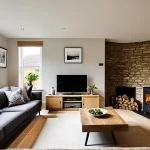Key Trends Shaping UK Home Living in 2024
Home living trends across the UK in 2024 reflect a dynamic blend of interior design innovations, technological progress, and sustainable considerations. These evolving tastes and practices illustrate the ways in which homeowners respond to lifestyle changes and environmental concerns.
Interior design trends have notably shifted towards embracing natural materials, warm colour palettes, and tactile textures. This includes an increased preference for woods, layered fabrics, and earthy tones, which create inviting, cosy environments. Multifunctional layouts are designed to accommodate fluid living patterns, supporting activities such as remote work and leisure seamlessly within shared spaces. The mix of vintage, artisan, and biophilic elements contributes to homes that feel personal and connected to nature.
Also to discover : How Can You Transform Your UK Home into a Welcoming Oasis?
Integral to modern UK homes is the surge in smart home technology, transforming everyday living. Devices like voice assistants, smart lighting, and advanced security systems are now commonplace, offering convenience, energy savings, and improved safety. Energy management solutions integrated into home automation systems enable precise control over heating and electricity usage, enhancing efficiency without sacrificing comfort.
Sustainability is no longer optional but a defining feature of UK home living trends. The emphasis on eco-friendly practices manifests through the adoption of green building materials such as insulated panels and low-VOC paints. Homeowners invest in renewable energy solutions including solar panels and heat pumps, drastically reducing carbon footprints. Alongside energy efficiency, there is a growing commitment to recycling, low-waste lifestyles, and supporting products designed for circular economies—actions that have become central to contemporary home environments.
Also to discover : How Can You Incorporate Vintage Style into Your British Home Decor?
Together, these trends—design, technology, and sustainability—create homes that are adaptive, efficient, and mindful of both personal wellbeing and environmental impact, framing the future of UK home living.
Adoption of Smart Home Technologies
Smart home technology UK is experiencing significant growth, becoming a core feature of modern homes. Common smart home devices UK include voice assistants such as Amazon Alexa and Google Assistant, smart lighting systems, and integrated security cameras. These devices enable homeowners to control various functions remotely or through voice commands, enhancing convenience and security.
Home automation extends to energy management systems that allow precise monitoring and adjustment of heating and electricity use. For example, smart thermostats learn user routines, optimizing energy consumption while maintaining comfort. This promotes sustainability alongside ease of use, aligning with broader UK home living trends prioritizing efficiency and environmental responsibility.
Connected living advancements facilitate seamless interaction between devices, creating intuitive living environments. Security systems now offer real-time alerts and remote access, improving safety. Smart lighting adapts to natural light levels and occupancy, reducing waste. Such technologies greatly impact daily routines by simplifying tasks, reducing energy bills, and contributing to a smarter, more responsive home experience.
Emphasis on Sustainable and Eco-Friendly Practices
Sustainable home practices have become a cornerstone of UK home living trends, reflecting a strong shift towards environmentally responsible choices. A key aspect is the widespread adoption of green building materials, such as insulated panels and low-VOC paints, which minimize harmful emissions and improve indoor air quality. These materials not only enhance the sustainability of homes but also contribute to energy efficiency by improving thermal insulation.
Homeowners increasingly invest in energy-efficient technologies, including solar panel installations and heat pumps, as part of their commitment to eco-friendly living. These systems reduce reliance on fossil fuels and lower carbon footprints significantly, aligning with broader national goals for carbon neutrality. Furthermore, green home technology extends to appliances designed to consume less energy while delivering optimal performance.
Beyond energy management, sustainable living UK embraces practices like recycling and low-waste lifestyles. Many households prioritize products crafted for circular economies, which promote reuse and reduce landfill waste. This trend highlights a conscientious consumer base that values durability, repairability, and ethical production in everyday items.
Together, these initiatives position eco homes not only as a response to environmental concerns but also as practical, cost-effective solutions that increase property value and improve quality of life through healthier, more efficient living spaces.
Key Trends Shaping UK Home Living in 2024
UK home living trends in 2024 showcase a blend of creative interior design innovations, rapid growth in smart home technology UK, and a strong commitment to sustainable home practices. These combined forces are significantly reshaping how residents conceive and use their living spaces.
Current interior design trends feature a pronounced shift toward warmer, natural colour schemes and rich textures. Homeowners favour materials like timber, wool, and linen that bring tactile comfort and visual warmth. Multifunctional layouts are increasingly popular, with dedicated zones that support working remotely, leisure, and family living coexisting fluidly. Additionally, the integration of vintage pieces, artisan crafts, and biophilic touches—such as indoor plants and natural light—strengthens the connection to nature and personal expression within the home environment.
Simultaneously, the expansion of smart home technology UK is accelerating. Devices ranging from voice assistants to smart lighting and advanced security systems are becoming integral parts of daily life. These technologies not only enhance convenience but also contribute to energy efficiency by enabling precise control over household systems. Connected living solutions ensure that various smart devices interact seamlessly, creating adaptive and user-friendly environments. This growth in home automation reflects a broader desire for homes that respond intelligently to occupants’ needs, increasing comfort and safety.
Sustainable home practices remain a defining aspect of UK home living trends. Adoption of eco-friendly materials such as low-VOC paints and insulated panels improves both environmental impact and indoor air quality. Homeowners are investing in renewable energy installations like solar panels and heat pumps, which lower carbon footprints and reduce energy costs. Beyond technology, lifestyle choices emphasizing recycling, minimizing waste, and supporting products made for circular economies demonstrate an enduring commitment to sustainable living. These eco-conscious efforts align with a national push toward greener, more resilient homes that foster well-being and reduce environmental pressures.
In sum, these evolving UK home living trends — from current interior design trends through the embrace of smart home technology UK to the rise of sustainable home practices — reflect a holistic approach to creating living spaces that are stylish, intelligent, and responsible.
Key Trends Shaping UK Home Living in 2024
Emerging UK home living trends in 2024 are marked by a sophisticated fusion of design innovation, technological advancement, and sustainability consciousness. The evolving landscape sees current interior design trends leaning heavily on natural textures, warm colour palettes, and layered materials that enhance tactile comfort. Popular styles now incorporate vintage and artisan elements, reflecting a desire for unique, personalised spaces that blend heritage with contemporary flair.
Alongside these aesthetic shifts, smart home technology UK continues to expand rapidly. Widespread adoption of voice assistants, smart lighting, and integrated security solutions has transformed daily living by introducing greater convenience and control. Advances in home automation and connected living networks enable seamless interaction between devices, allowing users to optimise energy consumption and enhance safety efficiently. These developments represent a technological stride toward homes that anticipate and adapt to occupant needs.
Equally vital is the growing emphasis on sustainable home practices, which underpin many residential decisions. Homeowners increasingly prioritise eco-friendly materials, such as low-VOC paints and improved insulation, which contribute to better indoor air quality and significant energy savings. Investment in renewable energy technologies—solar panels and heat pumps—reflects a broader commitment to reducing carbon footprints. Complementing these are lifestyle trends focusing on reducing waste, recycling, and supporting products designed for circular economies, cultivating a comprehensive approach to environmental responsibility.
Together, these intertwined trends signal a new era in UK home living where style, innovation, and sustainability are harmoniously integrated to create spaces that are functional, beautiful, and responsible.
Key Trends Shaping UK Home Living in 2024
UK home living trends in 2024 continue to evolve through a strong interplay of innovative design, smart home technology UK, and sustainable home practices. Notably, the integration of cutting-edge technology deepens, with homes increasingly utilising connected living solutions to streamline daily activities and enhance energy management. Voice assistants, smart lighting, and security systems now form a crucial triad that contributes not only to convenience but also to improved efficiency and safety within modern households.
Simultaneously, current interior design trends show an evolving preference for materials and styles that foster comfort and personality. The use of natural fibers, textured fabrics, and warm colour palettes reflects a move towards creating inviting spaces that support diverse functions, from relaxation to remote working. Architectural layouts favour flexible zones, allowing homeowners to adapt rooms seamlessly according to evolving needs.
Sustainability remains central, with eco-conscious decisions permeating design and technology choices. More UK homeowners embrace sustainable home practices such as installing renewable energy systems, selecting low-impact materials, and adopting waste-reducing habits. These moves not only lower environmental footprints but also contribute to healthier living environments and long-term cost savings. The convergence of these trends underscores 2024 as a year where style, technology, and sustainability coalesce to define the future of UK home living.








